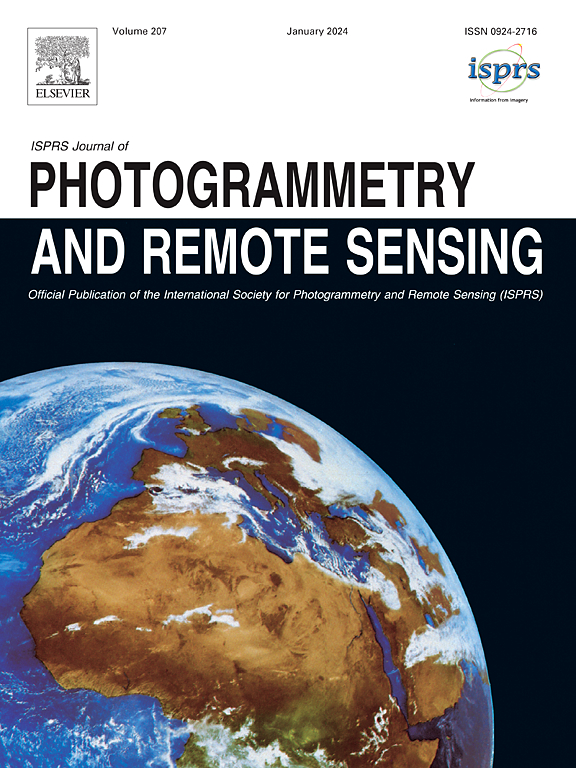利用无人机载热成像仪和基于 YOLO 的物体探测器自动定位堤坝渗漏口
IF 12.2
1区 地球科学
Q1 GEOGRAPHY, PHYSICAL
ISPRS Journal of Photogrammetry and Remote Sensing
Pub Date : 2024-10-02
DOI:10.1016/j.isprsjprs.2024.09.039
引用次数: 0
摘要
渗漏引起的水土流失是堤坝溃决的主要威胁,尤其是在洪水期间。及时发现渗漏口并通知堤坝管理部门对确保堤坝安全至关重要。然而,目前识别渗漏口的主要方法是人工检查,这种方法成本高、效率低,而且缺乏空间覆盖。为了实现堤坝渗漏口的高效自动定位,本文提出了一种结合无人机、红外热成像和深度学习的创新策略。无人机用于堤坝表面感应。这些无人机拍摄的实时图像被发送到服务器,服务器上部署了训练有素的探测器。一旦检测到渗漏口,就会向堤坝管理人员远程发送警报信息。为了实现这一战略,我们使用了 4 台热成像仪对多个模型和实际堤坝的渗漏口进行成像。选取了 9,231 张带有 13,387 个泄漏对象的手工标记热图像进行分析。使用迁移学习训练了 19 个探测器。在具有挑战性的测试集中,最佳检测器的平均精度达到了 95.8%。为进行泄漏出口检测测试,建造了一个完整规模的堤坝。各种现场测试证实了所提出的渗漏口定位方法的效率。在一些苛刻的条件下,训练有素的检测器也明显优于人工判断。结果表明,在典型情况下,建议方法的定位误差在 5 米以内,证明了其实用可靠性。最后,对建议策略的影响因素和局限性进行了深入研究。本文章由计算机程序翻译,如有差异,请以英文原文为准。
Automated localization of dike leakage outlets using UAV-borne thermography and YOLO-based object detectors
Leakage-induced soil erosion poses a major threat to dike failure, particularly during floods. Timely detection and notification of leakage outlets to dike management are crucial for ensuring dike safety. However, manual inspection, the current main approach for identifying leakage outlets, is costly, inefficient, and lacks spatial coverage. To achieve efficient and automatic localization of dike leakage outlets, an innovative strategy combining drones, infrared thermography, and deep learning is presented. Drones are employed for dikes’ surface sensing. Real-time images from these drones are sent to a server where well-trained detectors are deployed. Once a leakage outlet is detected, alarming information is remotely sent to dike managers. To realize this strategy, 4 thermal imagers were employed to image leaking outlets of several models and actual dikes. 9,231 hand-labeled thermal images with 13,387 leaking objects were selected for analysis. 19 detectors were trained using transfer learning. The best detector achieved a mean average precision of 95.8 % on the challenging test set. A full-scale embankment was constructed for leakage outlet detection tests. Various field tests confirmed the efficiency of the proposed leakage outlet localization method. In some tough conditions, the trained detector also evidently outperformed manual judgement. Results indicate that under typical circumstances, the localization error of the proposed method is within 5 m, demonstrating its practical reliability. Finally, the influencing factors and limits of the suggested strategy are thoroughly examined.
求助全文
通过发布文献求助,成功后即可免费获取论文全文。
去求助
来源期刊

ISPRS Journal of Photogrammetry and Remote Sensing
工程技术-成像科学与照相技术
CiteScore
21.00
自引率
6.30%
发文量
273
审稿时长
40 days
期刊介绍:
The ISPRS Journal of Photogrammetry and Remote Sensing (P&RS) serves as the official journal of the International Society for Photogrammetry and Remote Sensing (ISPRS). It acts as a platform for scientists and professionals worldwide who are involved in various disciplines that utilize photogrammetry, remote sensing, spatial information systems, computer vision, and related fields. The journal aims to facilitate communication and dissemination of advancements in these disciplines, while also acting as a comprehensive source of reference and archive.
P&RS endeavors to publish high-quality, peer-reviewed research papers that are preferably original and have not been published before. These papers can cover scientific/research, technological development, or application/practical aspects. Additionally, the journal welcomes papers that are based on presentations from ISPRS meetings, as long as they are considered significant contributions to the aforementioned fields.
In particular, P&RS encourages the submission of papers that are of broad scientific interest, showcase innovative applications (especially in emerging fields), have an interdisciplinary focus, discuss topics that have received limited attention in P&RS or related journals, or explore new directions in scientific or professional realms. It is preferred that theoretical papers include practical applications, while papers focusing on systems and applications should include a theoretical background.
 求助内容:
求助内容: 应助结果提醒方式:
应助结果提醒方式:


